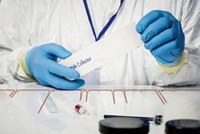Advertisement
Grab your lab coat. Let's get started
Welcome!
Welcome!
Create an account below to get 6 C&EN articles per month, receive newsletters and more - all free.
It seems this is your first time logging in online. Please enter the following information to continue.
As an ACS member you automatically get access to this site. All we need is few more details to create your reading experience.
Not you? Sign in with a different account.
Not you? Sign in with a different account.
ERROR 1
ERROR 1
ERROR 2
ERROR 2
ERROR 2
ERROR 2
ERROR 2
Password and Confirm password must match.
If you have an ACS member number, please enter it here so we can link this account to your membership. (optional)
ERROR 2
ACS values your privacy. By submitting your information, you are gaining access to C&EN and subscribing to our weekly newsletter. We use the information you provide to make your reading experience better, and we will never sell your data to third party members.
Policy
Anthrax Analyzed
Technology helps investigators build case against government researcher
by Rochelle Bohaty
August 11, 2008
| A version of this story appeared in
Volume 86, Issue 32
USING NEW and sophisticated scientific techniques, investigators have made substantial progress in the seven-year-old anthrax investigation, the FBI has confirmed. This information comes only days after the lead suspect committed suicide.
When Bruce E. Ivins, a senior biodefense researcher at the U.S. Army Medical Research Institute of Infectious Diseases (USAMRIID) in Fort Detrick, Md., died on July 29, federal prosecutors were about to identify him as the one who sent the 2001 letters laced with anthrax and charge him with killing five people and injuring 17 others.
According to government officials "a scientific breakthrough" that creates a DNA equivalent of a fingerprint allowed investigators to identify the origin of the anthrax used in the 2001 mailing and link Ivins to the crime. The FBI, with help from the scientific community, developed four individual, highly sensitive, specific tests to detect the unique qualities of anthrax, government officials said.
One company that has been developing and marketing such a technology is Carlsbad, Calif.-based Ibis Bioscience. Ibis Vice President of Research Steven A. Hofstadler confirms having a service contract with the FBI, but he will not comment, because of the ongoing investigation, on any details regarding anthrax, despite a recent publication on the topic (Emerg. Infect. Dis. 2008, 14, 653). He tells C&EN that the FBI has three Ibis systems.
The technology developed by Ibis, and presumably used by the FBI, uses specifically targeted primers and the polymerase chain reaction to amplify highly conserved genomic regions. The amplified products are analyzed by electrospray ionization time-of-flight mass spectrometry followed by base composition analysis to identify and determine the relative quantity of pathogenic bacteria in a sample. Multiple genomic regions can be amplified in parallel for a given sample. High-resolution genotyping of a specific species can be achieved with additional primers targeted to flank highly variable regions of a specific genome.
Court documents reveal that more than 1,000 anthrax isolates were compared with the anthrax used in the attacks. Only eight of these isolates contained the four genetic markers that characterized the mailed anthrax. All eight isolates are directly related to a single anthrax strain stored in a secure location at USAMRIID, where Ivins was the sole custodian since 1997.





Join the conversation
Contact the reporter
Submit a Letter to the Editor for publication
Engage with us on Twitter